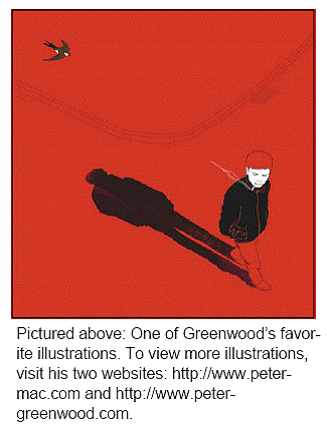For Peter Greenwood, a successful freelance illustrator, GIST is a burden and a tool. Like most GIST patients he feels the pressure of scans and occasional hopelessness. But despite all of this, Peter has found ways to use GIST to his advantage, to use it for inspiration by using his illustrations as tools to fight GIST. “[My illustrations] helped me come to terms with [GIST] and give me hope; I think that’s what I’ve found. One of the images I did recently is the idea of kind of being looked after, that I was in the right hands and it’s all going to be okay. It’s an image I’m really pleased with, I feel like someone’s looking after me. It gives me solace.”
Peter, who lives in Brighton on the south coast of the United Kingdom, uses a computer to transform his sketches into works of art. His sketch is scanned into the computer, which he then uses to color the drawing. “The possibilities for manipulating and working on images are quite vast [with computers]. You can produce images that you never could with paint.”
Peter spends his time working on commercial illustrations as well as his own. “I do illustrations that I am commissioned to do, and also I create my own work, which keeps me sane.” Peter works for book and magazine publishers and advertising agencies. “It can be a little soulless doing that and it can be quite restrictive, that’s when I do my own work.”
Peter has illustrated numerous book covers in the United Kingdom under the names of Peter Greenwood and Peter Mac and recently illustrated a mural for the entrance for the head office of Greater Manchester Transport; it measured an impressive 40 feet by eight feet. He got his inspiration from experts such as Ralph Steadman, illustrator of Fear and Loathing in Las Vegas and W. Heath Robinson, who illustrated many of Hans Christian Andersen’s works including The Arabian Nights and Tales From Shakespeare.
Peter feels that his illustrations are a meditative act, “I get a break from having to worry about cancer.” He also ensures that he does not spend too much time on his commercial work. “I’m continually writing down ideas, and in the last few months I seem to be getting more direction in my personal work.”
The reason for Peter’s sudden creative burst could be the state of his health recently. “I’ve been great. I’m nine months on Glivec and it has been helping me. The last scan showed that my tumors are still shrinking and one has disappeared. It makes me feel like I can concentrate on my own work.”
 When Peter is not using his art to support him through GIST, he has plenty of places to turn. He is able to get a great deal of support from groups like The Life Raft Group, GSI and GIST Support UK, as well as his family (Peter has two kids, a “fantastic, supportive” wife, Clare, two rabbits, one “mad pup” named Midgley and three chickens). Although he enjoys watching live music and tinkering with his old Citroën DS, Peter really loves spending time with his family. “My greatest realization from having GIST has been that my family is so important to me. We have become a tight unit and are very loving to each other, and this is precious!”
When Peter is not using his art to support him through GIST, he has plenty of places to turn. He is able to get a great deal of support from groups like The Life Raft Group, GSI and GIST Support UK, as well as his family (Peter has two kids, a “fantastic, supportive” wife, Clare, two rabbits, one “mad pup” named Midgley and three chickens). Although he enjoys watching live music and tinkering with his old Citroën DS, Peter really loves spending time with his family. “My greatest realization from having GIST has been that my family is so important to me. We have become a tight unit and are very loving to each other, and this is precious!”
Peter is someone who insists on living life to the fullest and never lets GIST hold him down. His favorite quote is by filmmaker Marcel Pagnol, “Everyone knew it was impossible, except for one idiot who went ahead and did it.” This quote truly describes Peter’s outlook on life and GIST as well. “I have learned not to worry about the future too much and I know it’s an old cliché, but I have moments of living in the present. That is a very important lesson to learn.”
He is also confident in the abilities of the medical community. “Through the LRG I can keep an overview on all that is going on medically, my hopes are that they are really going to crack it.”
Peter recently read a book that he believes is useful to anyone living with cancer, Man’s Search for Meaning by Viktor Frankl. “He was a Jewish prisoner in Auschwitz. What he talks about is whatever awful situation humans are involved in, they can always manage to find a way of having hope and creatively making the situation ok for them. The ideas spoke volumes to me and other patients as well. It really speaks to the cancer patient; you replace concentration camp with cancer. Those prisoners didn’t know when or if their time would come, the comparisons are all there. They were still able to have dignity.”

